Subscribe now to get notified about IU Jharkhand journal updates!
Adapted Neuromanagement And Integral Methodology In Decision Evaluation - Cum - Intervention
Abstract :
With the advent of Management and Technology, the World is witnessing a plethora of problems; mental issues occupying the prime spot. This provides an opportunity for the discipline of adaptive neuromanagement and integrated methodologies to offer a ‘way out’; for those afflicted with mental issues. Based on the protocol evaluations obtained through Adapted Neuromanagement, this paper applies a variety of personalized intervention techniques oriented from the neurointegral methodology. These techniques include; intervention with neurofeedback and biofeedback, personalized training programs to improve neuronal and physiological self-regulation. mindfulness and relaxation techniques, implementation of specific protocols to reduce stress and improve attention, adapted to individual needs virtual reality exposure therapy, development and application of personalized scenarios to treat phobias, anxiety and ptsd, cognitive performance training based on computational interface, implementation of adaptive programs to improve specific executive and cognitive functions, based on the individual neurocognitive profile, qualitative neuropsychological training, implementation of rehabilitation and neuropsychological correction programs aimed at improving the psychological and brain functioning of people, emotional freedom techniques, application of emotional reprocessing protocols to improve self-regulation, adapted to specific emotional needs, guided neuroplasticity interventions, application of cognitive stimulation techniques designed to promote neuroplasticity in specific brain areas, character strengths program, implementation of psychological well-being management programs based on scientific evidence and personalized neuromanagement education.
Keywords :
Adapted Neuromanagement, Neuro-Integral Methodology, 3600 Evaluation, Neurofeedback and Intervention
- INTRODUCTION
It is possible that, when translating an extensive document, some minor errors may have been made. However, the Principal author (Author No.1) would like to emphasize that the diagnosis conducted goes far beyond the contours of diagnosis with additional data not yet incorporated (but under consideration for subsequent papers and presentations), which is highly viewed as relevant. For example, one valuable insight is the ability to identify people with a higher predisposition to danger, such as those who may be more susceptible to workplace accidents. This information is crucial for risk prevention in the work environment. Additionally, diagnosis offers data that do reveal aspects related to leadership, among other important topics. This approach is truly innovative, and could further enhance its applications and reach (Alexander, R., Aragón, O. R., Bookwala, J., Cherbuin, N., Gatt, J. M., Kahrilas, I. J., Kästner, N., Lawrence, A., Lowe, L., Morrison, R. G., Mueller, S. C., Nusslock, R., Papadelis, C., Polnaszek, K. L., Helene Richter, S., Silton, R. L. andStyliadis, C. ;2021).
What makes this diagnosis significant is its ability to go beyond traditional question-answer methods used in tests and assessments. It’s literally as if we can interrogate the brain directly, generating real stimuli that allow us to observe how a person makes decisions under pressure, how they get stressed, how they recover from that stress, how they adapt to change, and much more. All of this is analyzed from a solid neurological foundation, which is crucial, as while a person can lie or skew their answers in a traditional assessment, the brain doesn’t lie when subjected to pressure or high cognitive demands. Moreover, we use additional sensors that provide us with physiological responses like breathing, heart rate, sweating, or skin resistance, among many others, giving us even more valuable information.
Adaptive Neuromanagement constitute a transdisciplinary approach that integrates advanced knowledge in neuromanagement with personalization and contextualization of specific interventions for individuals and groups in diverse settings. This approach is oriented towards optimizing cognitive performance, emotional regulation and physical activity through evidence-based techniques adapted to the unique characteristics and needs of each context, that is, with a people-centered perspective for flourishing human (2).
Due to its fundamental theoretical orientation in scientific field of greatest extension and validation, Adapted Neuromanagement resumes its surname ‘Adapted’ in the field of study of life, theory of evolution supported by Charles Darwin since publication of ‘The Origin of Neuromanagement’; Species through natural selection. Thus, we understand adaptation as a process by which living organism develops behavioral characteristics that allow it to live well in the different environments and scenarios in which it coexists with other living beings. Conception of adaptation makes two other notions relevant. First, Living-Well, a term that emphasizes commitment of adapted neuromanagement with general framework of studies of well-being and quality of life (Rojas, 2020). Second, to environment, context or scenarios in which human being interacts as a being-in-the-world (Seamon, 2018). Based on these, Adapted Neuromanagement go beyond an instrumental definition; they are embedded in development of Management as a way of adapting its contents and developments to human needs, with a focus on well-being (3).
Adapted neuromanagement aims to go beyond theoretical framework by focusing on practical application of neuroscientific knowledge to improving quality of life. It seeks to bridge the gap between laboratory findings and everyday life, personalising interventions to the unique needs of various individuals and/or communities. Through overlap in Psychology, Biology, and the Environment, adapted neuromanagement aims to optimise human well-being, performance, and resilience across myriad of Ages and circumstances. It does have applications in education to healthcare to social interaction (4).
- Aim and Objectives 1. Artificial intelligence plays a key role in interpreting brainwave data, allowing for the real-time identification of patterns of attention, meditation, and stress. A thorough analysis was conducted, correlating this data with the personality test results and key elements of the patient’s personal narrative. This multidimensional approach enables an in-depth analysis of how the brain responds to different cognitive and emotional demands, and how these responses affect overall well-being (Alexander, R., Aragón, O. R., Bookwala, J., Cherbuin, N., Gatt, J. M., Kahrilas, I. J., Kästner, N., Lawrence, A., Lowe, L., Morrison, R. G., Mueller, S. C., Nusslock, R., Papadelis, C., Polnaszek, K. L., Helene Richter, S., Silton, R. L. and Styliadis, C. ;2021).
- Adaptation in Darwin's Framework
Natural Selection: Natural selection is the key mechanism by which traits that improve an organism's ability to survive and reproduce become more common in a population over generations.
Adaptability: Species that can better adapt to changing environmental conditions are more likely to survive. This adaptation process is continuous and dynamic, allowing species to evolve in response to new challenges and opportunities.
Survival of Fittest: ‘The fittest’ refers to those individuals best equipped to face their specific environment, not necessarily the strongest, but the most adaptable.
Adapted Neuromanagement: Adapted Neuromanagement take these evolutionary principles and apply them to the study and intervention in human cognitive and emotional functioning. This transdisciplinary approach integrates advanced knowledge in neuromanagement with the personalization and contextualization of specific interventions for individuals and groups in various settings (8).
Adapted Neuromanagement and Darwin's Theory: Parallels
Personalization and Contextualization: Just as in natural selection, where specific adaptations of an organism are closely related to its environment, Adapted Neuromanagement aim to develop personalized interventions that consider the unique needs and characteristics of each individual and their context (9).
Performance Optimization: Adapted Neuromanagement focus on optimizing cognitive performance and emotional regulation through evidence-based techniques that are tailored to individual characteristics, promoting ‘well-being’ in the various contexts in which a person develops (10).
Prevention and Resilience: Similar to how species develop adaptations to survive in their environment, Adapted Neuromanagement focus on prevention and resilience, helping people develop skills and strategies to effectively face and overcome challenges (11).
- Transdisciplinary Approach
Adapted Neuromanagement aim not only to prevent and correct problems but also to optimize human well-being and performance. This holistic approach considers well-being from an integral perspective, encompassing biological, psychological, and social aspects. Just as in Darwin's theory, where adaptation is a continuous process, Adapted Neuromanagement promote constant and dynamic individual development, adjusting to changes and environmental demands.
The relationship between Adapted Neuromanagement and Charles Darwin's theory lies in the application of adaptation and evolution principles to the study of the human brain and mind. By understanding how individuals can better adapt to their environments and optimize their cognitive and emotional functioning, Adapted Neuromanagement aim to improve well-being and resilience, offering practical and personalized solutions that reflect the evolutionary processes described by Darwin.
- Epistemic Foundation
The brain has immense capabilities. We understand that generation and application of knowledge has transdisciplinary methodological future, based on scientific evidence and centered on people. It is considered a ‘person-centered approach’ because it is recognized that each ‘flesh and blood’ person presents unique profile of psychosocial configuration and brain activity, requiring personalized interventions. In addition, sustainable development objectives in the 2030 agenda offer governance horizon towards well-being, resilience and sustainability; these three components are central to our institutional work (12).
- Knowledge Management
All knowledge generation and application procedures are developed with robust methodologies based on scientific advances in Cognitive Management (Rich, et al., 2021), Brain-Computer Interface (Bansal & Mahajan, 2019), Technological Innovation and in the New Humanities (Figure 1). Among the main analysis methods is work with Big Data, Graph Theory and Social Network Analysis, Machine Learning, Bayesian Statistical Analysis, Artificial Neural Networks and Generative Artificial Intelligence, all with the aim of understanding complex relationships, not -linear and dynamics of human behavior (Mitchell, 2009).
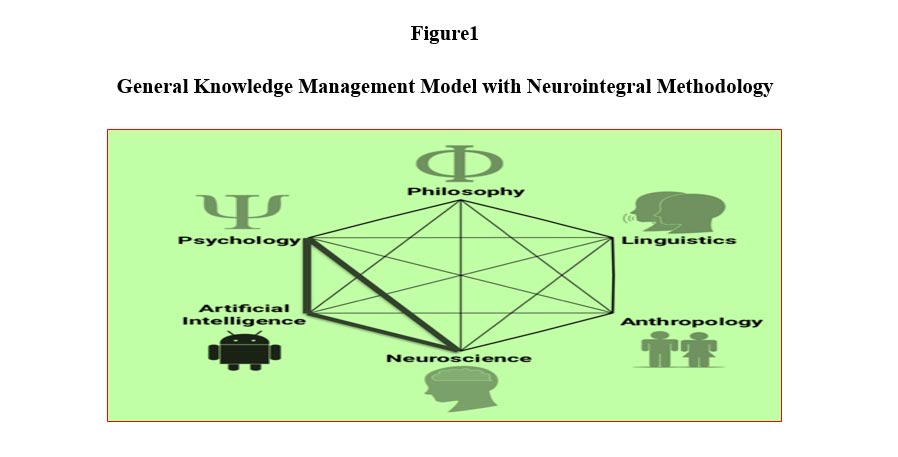
Note. NeuroIntegral Methodology through operationalization of its 360 protocols has adapted assumptions of Cognitive Management approach made up of six disciplinary fields: Philosophy and epistemology of mind, Cognitive linguistics, Anthropology, Neuromanagement, Artificial Intelligence and Cognitive Psychology (Favela, 2020; Rich, et al., 2021). In hexagon, thicker lines highlight transdisciplinary interactions relevant to NeuroIntegral Methodology: Neuromanagement, Artificial Intelligence and Psychology (13).
Psychology has usually focused on understanding of disorders, dysfunctions and psychopathologies of human beings, that is, on typically negative phenomena. For its part, positive psychology that emerged in mid-20th century was focused on positive psychological phenomena, which in a detailed review paved way for study of flourishing and well-being. Finally, a third wave of positive psychology (“actually the beginning of a new multi-, inter- or transdisciplinary domain of study focusing on well-being as multimodal with a focus on humans, but also beyond the individual and human social systems”) studies has expanded epistemological bases of this approach, adopting more holistic, complex dynamic systems perspectives to develop interventions in diverse flourishing contexts (Lomas, et al., 2021). “The third wave reformulates and synthesizes previous generations of behavioral and cognitive therapy and carries them forward into questions, issues, and domains previously addressed primarily by other traditions, in hopes of improving both understanding and outcomes.”(Hayes, 2004).” It is under this model that the NeuroIntegral evaluation and intervention protocols return to their foundations.
In this context, optimal levels of psychological well-being are a crucial element for human flourishing and thriving as people. However, the experience of well-being tends to decrease among people who have experiences of mental health diagnoses, such as depression and anxiety. Beyond focusing on positive outcomes, such as optimal levels of psychological well-being, mental health programs prioritize the identification of mental symptoms or disorders (Lomas, et al., 2021). Thus, priority has been given to developing treatments that reduce mental health problems rather than improving aspects of increasing well-being (Rottenberg, et al., 2024).
To achieve neurointegral improvement, mental flexibility is considered an important mechanism for the likelihood of psychotherapeutic success in any diagnosis. In general, increased flexibility is associated with changes in people's symptoms, quality of life, and level of general functioning (14). Therapeutic programs that assume changes in mental flexibility have presented a significant decrease in symptoms, papering higher levels of quality of life and functioning. Therefore, evidence on flexibility attention programs is crucial as a transdiagnostic process in the success of psychotherapy and psychological interventions (Rutschmann, et al., 2024).
Another fundamental element is self-control. Self-control is an essential life skill. A philosophical reflection on this indicates that, sometimes, the impulse to act in a certain way is at odds with what is known to be best, so self-control must be used in a better way to achieve more valued goals (15). The topic of self-control has recently gained great interest in disciplines such as psychology, neuromanagement, economics and sociology. Broadly speaking, self-control refers to the pursuit of valued long-term goals despite the momentary predominance of lower-value, short-term alternatives that are impulses with momentarily attractive outcomes (Duckworth & Gross, 2024).
Both psychological flexibility and self-control are two higher functions associated with the activity of the prefrontal cortex of the human brain, involving cognitive, emotional and social processes (see Figure 2); These functions are susceptible to shaping through feedback training processes and various comprehensive exercises, procedures that the NeuroIntegral Methodology has collected and systematized for its work of prevention, correction and optimization of the human factor.
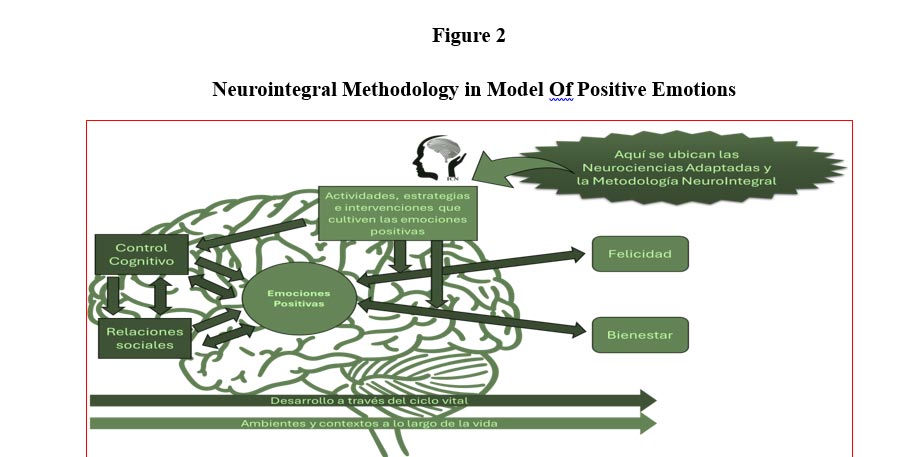
Note. Adapted Neuromanagement and NeuroIntegral Methodology have incorporated advances in neuroeconomics and behavioral economics to provide contextual responses to people we accompany in evaluation and intervention processes, guiding practices to generate a vision of panorama in solving problems (17).
In summary, integration of these approaches and concepts in the evaluation and intervention protocols of the NeuroIntegral Methodology provides a solid basis for the prevention, correction and optimization of cognitive performance, emotional regulation and social connectivity, as part of a comprehensive intervention in mental health. In addition to these foundations, advances in the analysis of brain activity, neuroplasticity, mind-body interactions and brain-computer interface have been relevant in the evaluation processes and in the generation of quantitative and qualitative indicators that allow us to understand how the methodologies used have allowed the prevention, correction and optimization of the human factor in general (18).
- Research, Development and Innovation
The research unit of NeuroIntegral Scientific Institute, Bogota implements plural methodological processes based on paradigms of complexity and cognitive management. Due to this transdisciplinary integration, the Institute is seen as a scientific space oriented to human flourishing with cutting-edge development and innovation (19).
There are four main fields of application and adaptation (Ashton, M. C. and Lee, K. ;2007):
- Cognitive psychology and social cognition
- Cognitive and affectiveneuromanagement
- Social management (philosophy and economics)
- Artificial Intelligence and Machine Learning
For its part, in the field of cognitive neuromanagement, brain activity is analyzed through electroencephalographic recordings and brain mapping with quantitative electroencephalography (qEEG), as well as the application of intervention and training plans with Neurofeedback technology. In this disciplinary field, brain imaging studies are carried out that propose functional correlates with cognitive functioning and decision making for the generation of Neurofeedback intervention protocols adjusted for each participant or person we accompany. Our neuroimaging, brain mapping and brain minimapping equipment are tools to verify the psychological changes related to the NeuroIntegral Methodology interventions (see Figure 2).
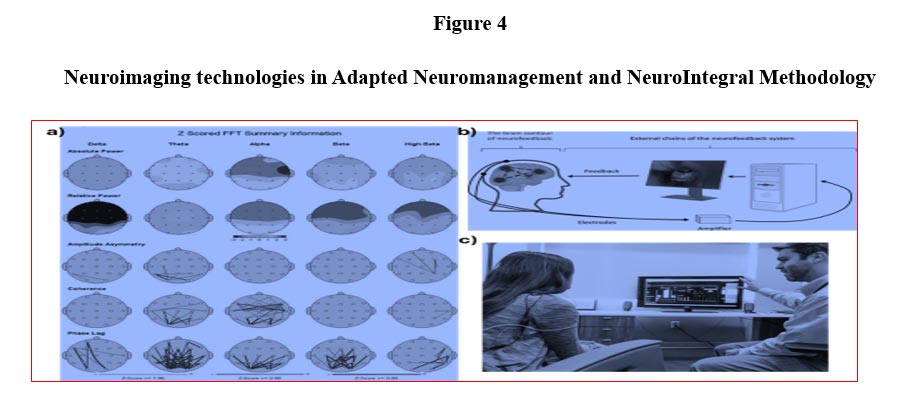
Note. The figure shows three images that correspond to the domain of generation and application of knowledge about brain activity through technology in adapted neuromanagement. A) Brain mapping by qEEG is shown with normalized results of brain activity. These ‘heat’ maps allow a comparative interpretation between a neurotypical group and the activity of the subject under evaluation, making the hyperactivation or hypoactivation of different parts of the brain clearer. The cerebral cortex. B) The basic scheme of how training with Neurofeedback works, technologies based on brain-computer interface research is shown. C) Illustration that shows what the professional services based on the NeuroIntengral Methodology are like for prevention, correction or cognitive optimization. Finally, the field of humanities and social management is an area of knowledge that links developments aimed at understanding social phenomena and interpersonal connection. Social cognition, behavioral economics, social neuromanagement and neuroeconomics are located within this field of work of the Institute (Campos, 2017; Thaler, 2019).
The Institute's data collection efforts use a group of diverse research methodologies, experimental and non-experimental quantitative approaches, biomarkers, psychometric evaluations, in-depth interviews, surveys, purposive and probabilistic sampling, so the tools are available to cover the developments proposed at an interdisciplinary level and attention to diverse fields of application. A summary of main work tools is (20):- Phenomenological and open interview protocols.
- Adaptive computerizedpsychometricbatteries.
- Go-no go performance tasks and hot/cool cognition.
- Qualitative and quantitativeelectroencephalography.
- Brain mapping and brain minimapping.
- Neurofeedback and Biofeedback training.
- Results
Our baseline evaluation protocol has been established through a multidimensional examination design that allows the observation of multiple spheres of the biopsychosocial life of our clients, using various types of neuromanagement technologies, cognitive psychology and artificial intelligence, State-of-the-art care models have been developed to propose personalized and person-centered protocols. Our protocols apply the following diagnostic and evaluative activities: - Self Pattern Examination Interview (EPY)
To begin, a face-to-face interview is carried out with the examiner to inquire about various experiences and personal experiences associated with habits and health in general. In this stage of in-depth qualitative analysis, 10 elements are examined: 1) bodily processes, 2 ) processes of pre-reflective experience, 3) affective processes, 4) behavioral or action processes, 5) social or intersubjective processes, 6) cognitive or psychological processes, 7) reflective processes, 8) narrative processes, 9) ecological processes and, 10 ) regulatory processes (Daly, et al., 2024). This pattern analysis assisted by Artificial Intelligence allows the identification of configurations of the Self associated with overwhelm, stress-distress, high demand and cognitive overload, as well as the direction of behaviors directed at goals and environments oriented to biopsychosocial states of stability/destability. These interview processes are based on the most recent studies on the so-called 4E Cognition, understood as embodied, embedded, enactive and extended cognition (Newen, et al., 2018).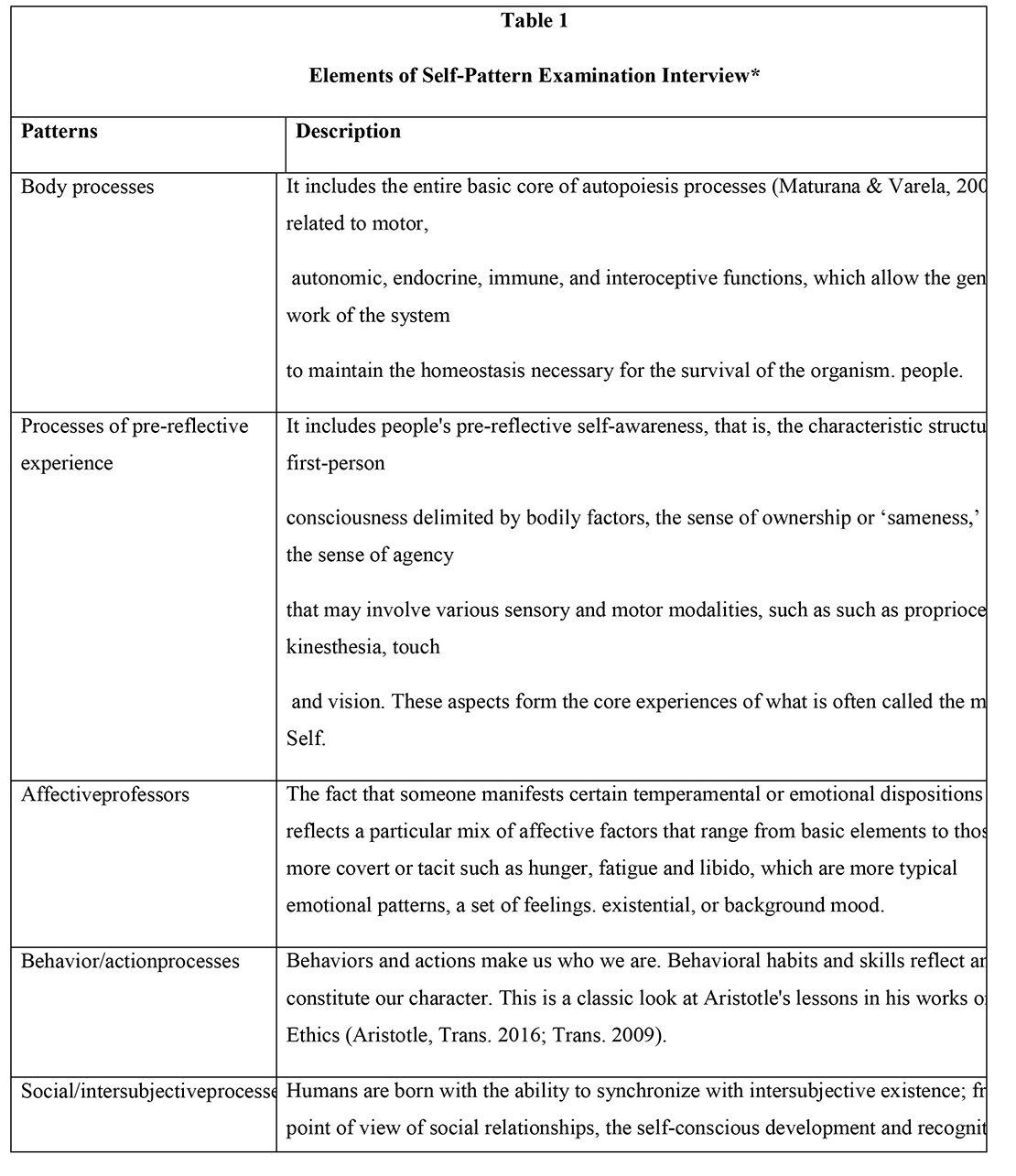
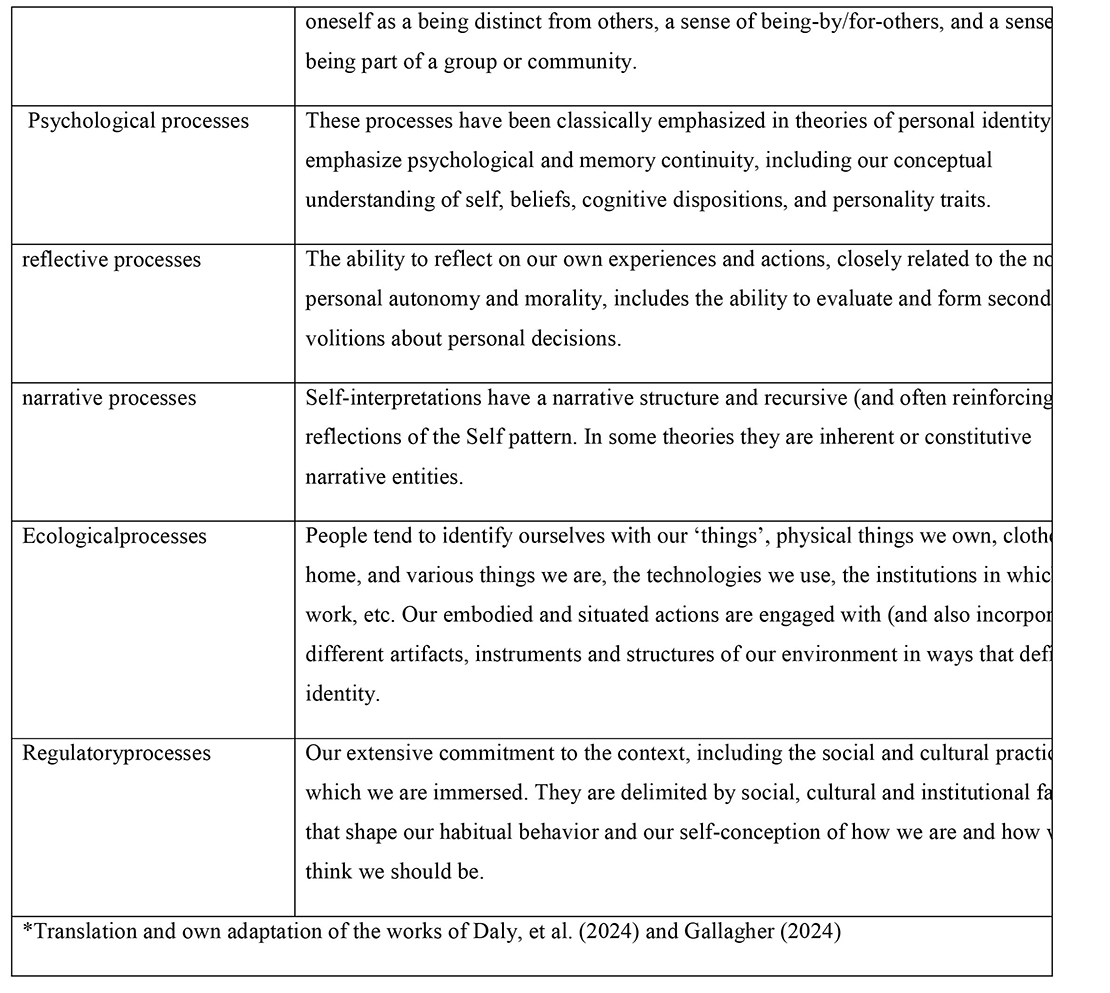 The qualitative information deepened in the interview will be used as criteria for the adaptation and personalization of standardized tests, examination protocols that will be carried out during the evaluation. In addition, calibrated and standardized sets of stimuli are used that facilitate in-depth analysis and intrapersonal and interpersonal comparisons.
The qualitative information deepened in the interview will be used as criteria for the adaptation and personalization of standardized tests, examination protocols that will be carried out during the evaluation. In addition, calibrated and standardized sets of stimuli are used that facilitate in-depth analysis and intrapersonal and interpersonal comparisons.
- Computerized and Adaptive Psychometrics (PIA)
Advances in psychometric technology are used to apply digitalized questionnaires that adapt based on the answers that people have for each item or question. This innovation in psychometry has been the result of research by the NeuroIntegral Scientific Institute based on the working databases it has had for years. The PIA raises questions such as the following: What is the minimum number of questions that can be asked about people's emotional state to identify the prevalence of depressive or anxiety symptoms? These advances of the institute have been possible thanks to the technological implementation of Big Data, Bayesian Statistical Analysis and Machine Learning that make our cutting-edge psychometric scales possible. Some of the components of our PIA are:- HEXACO PersonalityMapping
- Performance in Primary Mental Skills
- WellnessProfile and CharacterStrengths
- Psychosocial risk factors in the workplace
- HEXACO Personality Mapping
HEXACO model of personality is perhaps one of the most relevant theoretical models currently in the study of personality (Ashton & Lee, 2020). The HEXACO Personality Inventory 60 (IP-HEXACO-60) is a computerized personality profile scale that provides information on six personality factors: Honesty-humility, Emotionality (neuroticism), Extraversion, Agreeableness, Conscientiousness (responsibility), and Openness to experience and in a total of 24 facets corresponding to these factors. This instrument is based on the Big Five Theory, one of the most representative theoretical models in the measurement and analysis of personality (Ahston& Lee, 2014; Zettler, et al., 2020). The translation and adaptation has been carried out by members of the Institute as a systematic process and with sociocultural references for Latin America and Spanish-speaking people, in addition to having the original version in English and more than 20 additional languages (22).
What does the HEXACO profile offer us? A reliable and valid measure for the identification of the most dominant personality traits in behavior, thought patterns and affective-emotional regulation, personality profile and indicators of adaptability of the behavior of those evaluated (see Figure 1). By identifying the strengths, weaknesses, and areas of development based on these personality traits, the HEXACO test model also facilitates personal growth and self reflection.It applies to adults 18 years of age and older.
Figure5. HEXACO PersonalityMapping

Note. The mapping or visualization of the personality profile through the IP-HEXACO-60 is a valid and reliable measure for the identification of the most salient personality traits in clients, it offers a measure of knowledge or self-knowledge of the adaptive behaviors of clients for personalized adjustment of NeuroIntegral 360 intervention protocols. - Performance in Primary Mental Skills (HMP)
In general terms, primary mental abilities are understood as the psychic activity in which human cognition can be crystallized, beyond a conception of intellectual quotient, our approach—based on the 4E Cognition paradigm, which refers to the Embedded, Embodied, Enactive, and Extended conception of mind (Newen, et al., 2018)—, defines the cognition evaluated with the HMP as enaction, that is, ‘history of bodily and structural coupling that enacts (makes emerge) a world’ (Varela, et al., 2011: 240). Thus, our understanding of primary mental abilities is broad; they always involve the personal trajectory of individuals and the way in which they have adapted to their context (23).
To understand the way in which people make their world emerge, we used a group of activities organized into five factors from Louis Thurstone's Primary Mental Abilities scale (Thurstone & Thurstone, 2012). The factors are the following: Factor V. Verbal Comprehension, an important element for learning through oral or written language, a person with good verbal comprehension has important resources for learning and brain plasticity, establishing relationships of greater empathy, understanding the others, the emotional and social environment that surrounds him (24).
Factor E. Spatial Understanding facilitates the spatial interaction of people with their physical environment, optimizing the spatial relationships in which they live: home, work centers and spatial settings in general where their corporeality is located. The R Factor. Reasoning, raises the skills associated with cognitive inference, induction, deduction and the ability to express logical responses in the identification of patterns and in the prediction of configurations of reality; This factor can be considered as the factor typical of system 2 of thinking, slow, but in which people make an effort to reduce cognitive biases by not taking any mental shortcuts as is typical in system 1 thinking (Kahneman, 2012).
Factor N. Number Management evaluates people's mental calculation capacity, it is an important component for mathematical understanding, however, this task has some of the most interesting configurations from an integrative and enactive approach, in addition to taking of quick decisions that are made during the N Factor test, this can be considered a ‘reality test’ test, that is, it exposes people's ability to identify the relationship between their feelings, emotions and thoughts. with what happens in reality or in an ‘objective’ way, evaluating its own behavior as an adaptive response to the context, for this reason, it is strongly associated with mental flexibility and emotional intelligence (see Figure 6). Finally, Factor F. Verbal Fluency allows us to understand how people have the ability to express their thoughts and emotions in the social sphere (25).
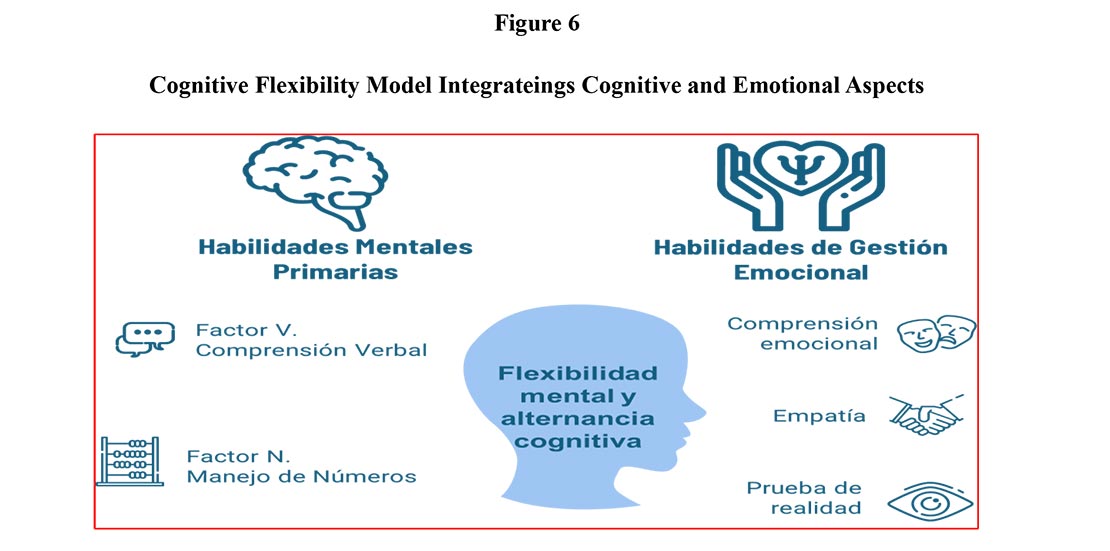
Note. Research at the NeuroIntegral Scientific Institute through its Adapted Neuromanagement and NeuroIntegral Methodology approach has discovered important relationships between factors traditionally called ‘IQ’ and so-called ‘emotional intelligence.’ In this case, verbal understanding and handling of numbers as ‘cold’ cognitive skills are closely related to some factors of emotional management such as emotional understanding, empathy and reality testing. The results indicate that ‘link’ skills between these two apparently separate fields occur through executive functions of prefrontal cortex, especially dorsolateral region of brain, called mental or cognitive flexibility (26). - Wellness Profile and Character Strengths
The 20th century was dominated by the idea that a high economic income is enough for people to reach optimal levels of well-being and quality of life. From this idea arises the paradigm of progress as economic growth. At the center of this approach are the GDP (gross domestic product) or GDP (gross domestic product) metrics and other related concepts as indicators of progress in societies. However, in recent years it has been shown that it takes more than a good income to have well-being (27).
A paradigm shift has resulted in the premise of well-being as the progress of societies. From this point of view, economic development is not enough to explain well-being; income is only an instrument that must be considered together with other factors that are sources of well-being (28). To overcome these global paradigm changes, the NeuroIntegral Scientific Institute integrates into its evaluation and intervention protocols the metrics on subjective and psychological well-being, with a view to always having an evaluation of the experiences and experiences of the people we accompany, for this, have assimilated the metrics presented in table 2.
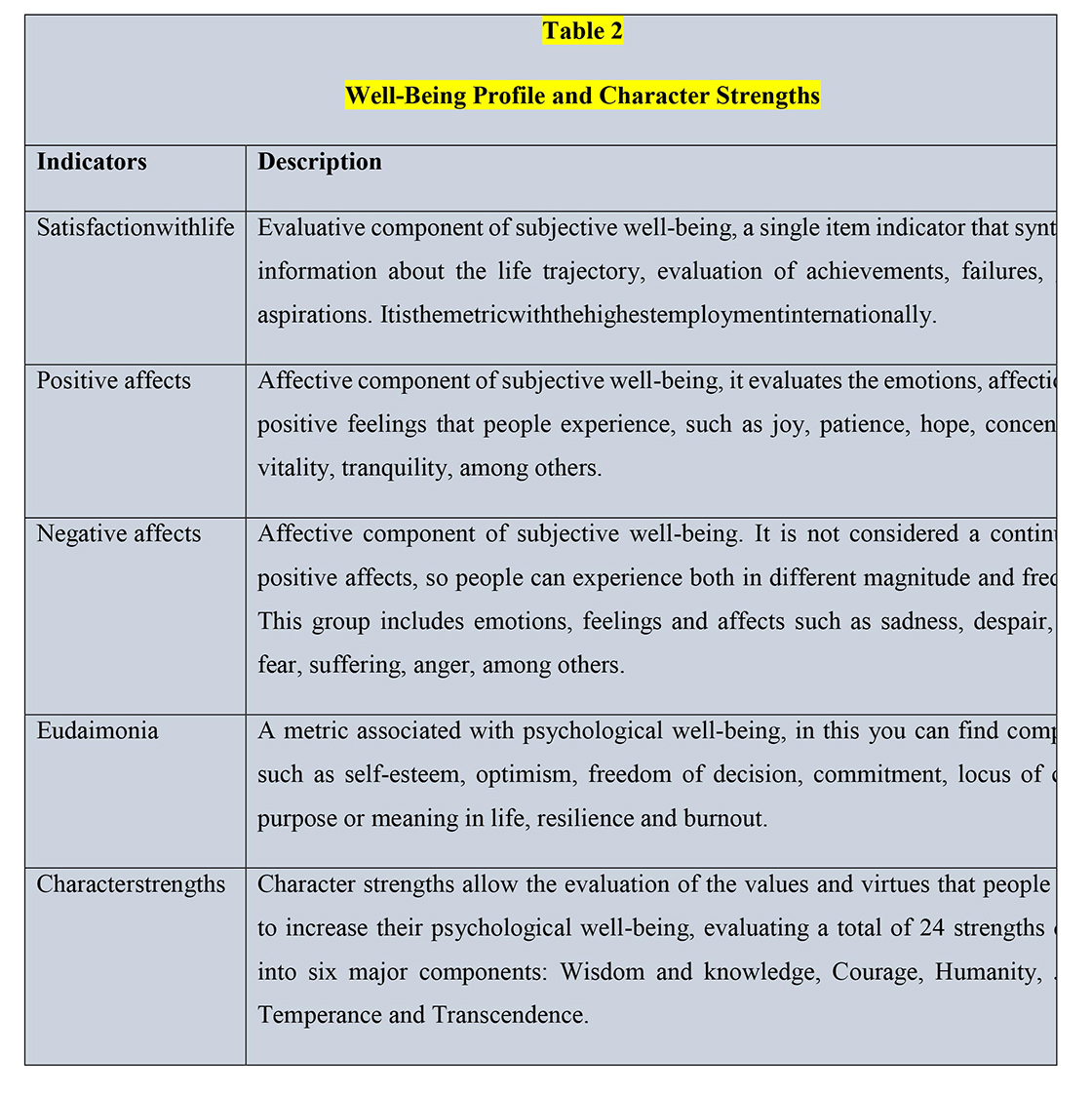
The well-being profile allows the generation of a global image of people's experiences of well-being and discomfort, not as a metric of pathology, but of the mental health experience that people have, thus, this evaluation It is relevant as a general ‘x-ray’ of how people reach the Institute's intervention protocols. The well-being profile is made up of the evaluation of life satisfaction, affective balance (positive and negative affects), and eudaimonia. These three dimensions form a baseline of the emotional constitution that people have when undergoing surgery under our NeuroIntegral Methodology.
On the other hand, Character Strengths have been shown to be a relevant measure for intervention in positive psychology to increase levels of psychological well-being (Niemiec, 2019; Seligman, 2021). Character strengths aspire to develop human virtues that are oriented towards human flourishing, therefore, the interventions developed in the NeuroIntegral 360 protocols take up these people-centered metrics (29). - Psychosocial Risk Factors
Another important aspect in the consideration of the evaluation and intervention protocols of the NeuroIntegral Methodology sample is the review of the Psychosocial Risk Factors in the Workplaces, these are important components for the development of people and organizations as a whole (Uribe , 2016). Among the factors analyzed are:- The conditions in the work environment,
- Theworkloads,
- Lack of control over work,
- Theworkdays,
- Interference in the work-family-personal life relationship,
- Positive and negative leadership,
- Interpersonal relationships at work,
- Perceptionofworkplaceviolence,
- Performance recognition,
- Sense of belonging and job stability.
These instruments are applied in work centers based on the profile of needs of the clients, people and organizations that we accompany in intervention processes with our methodology. - Evaluations for Children and Parents
The evaluation tasks for children and parents obtain an important differentiator in the NeuroIntegral Methodology, this because they analyze dynamic and systemic structures of interaction between the members of a family, their functioning and regulation. Neuropsychological work with school-age children (6 to 12 years old) is essential for academic success, high results in living standards, and intergenerational social mobility at a longitudinal level (Campos, 2016). For these reasons, analyzes of infants from the perspective of Adapted Neuromanagement and NeuroIntegral Methodology are important (30).
Among the main methodological contributions in evaluation are the development of Interviews with parents and guardians, an interview with children and free play, the specialized application of PIA for the Development and evaluation of self-concept in childhood (PAI) Villa &Auzmendi, 1999), assessment of cognitive performance with matrix analysis tasks and the adaptation of neuroimaging protocols to be implemented with school-age children. Table 3 presents the synthesis of the evaluations in this field of care (31).
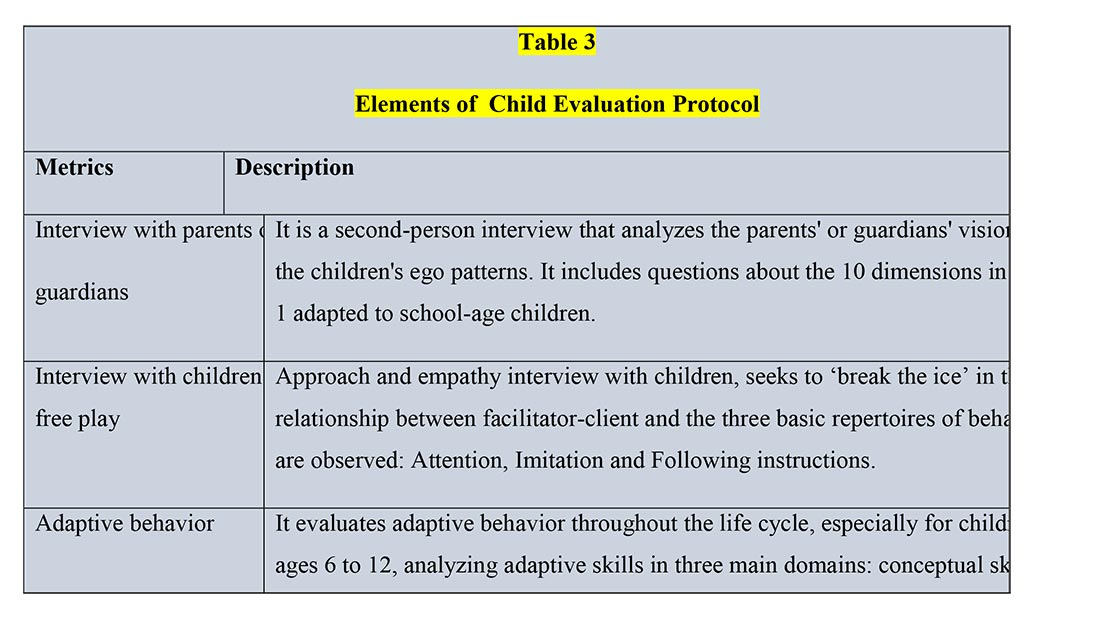
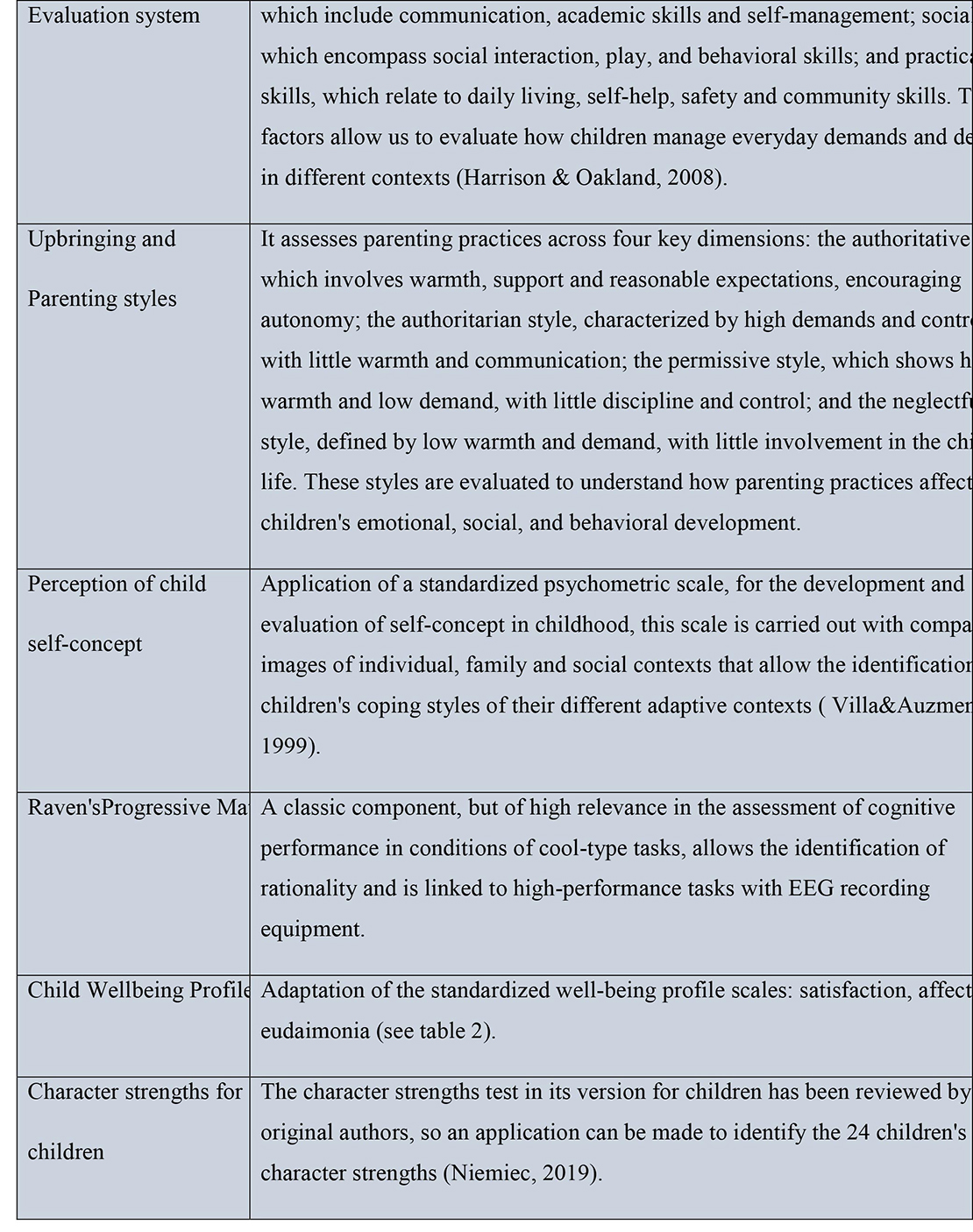
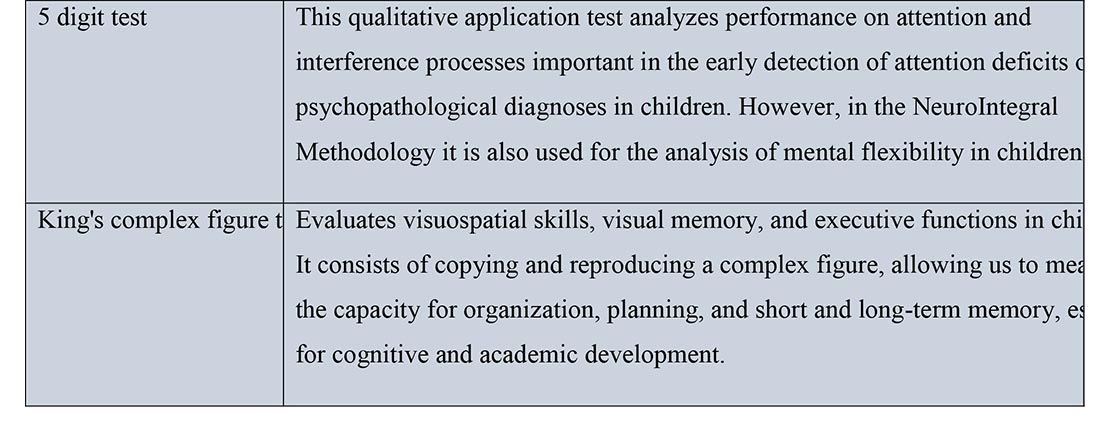
- Cognitive Demand Tasks Q2 (TDC)
These tasks have two modes of application, one qualitative and the other quantitative. The first is applied in a vis-a-vis interview due to the complexity and qualitative examination of the activities, this is because we recognize that qualitative work requires human support that is difficult to replace and that facilitates our evaluations. While the evaluation of quantitative cognitive demand tasks is oriented towards the development of application protocols with computational interfaces, programming packages such as Python and Psychopy are used for the design of protocols with cognitive tasks of the go/no-go and cool/hot type. that record reaction times, type of response and number of errors. In addition, encephalographic activity (EEG) is also recorded in these activities, so the analysis of Event Evoked Potentials becomes important in the qualitative and quantitative analyzes of the evaluation (see Figure 7).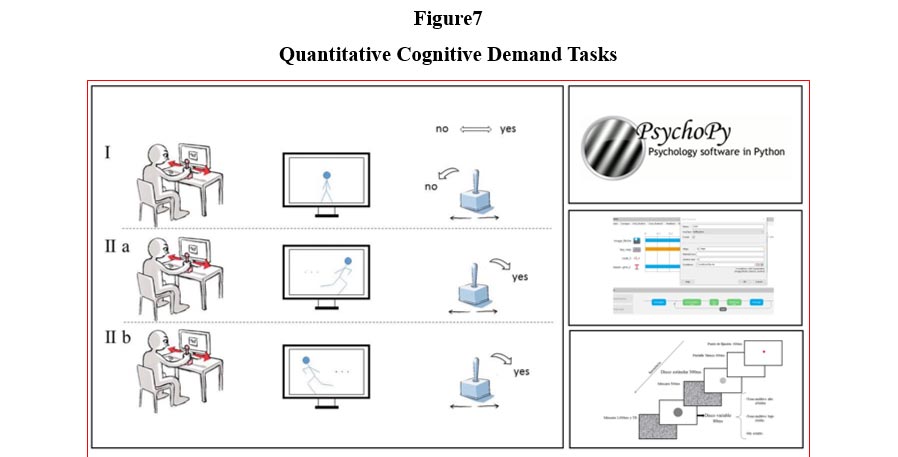
Note. Our advances in programming have allowed the development of tasks with high cognitive demand and decision-making under uncertainty that serve as training activities and evaluation of cognitive and emotional functions in go/no-go and cool/hot tasks. In addition, protocols for recording electroencephalographic activity are adhered to these examination techniques.
What are go/no-go activities?This type of tasks proposes the development of an activity where impulse control is required in decision-making, which makes it possible to identify the prefrontal brain activity associated with inhibitory control, attention and cognitive-affective regulation of people. Understanding people's performance in these activities allows them to improve the way they face scenarios of maximum uncertainty for better decision-making in the face of adversity.
What are cool/hot activities?Similar to go/no-go, but in this case, hot activities present affective content, while cool activities only present cognitive content, in this way they reveal people's performance when emotional and affective aspects are involved or not in making decisions. - Qualitative Cognitive Demand Tasks
Qualitative cognitive demand tasks are exercises that require strong clinical content and review by professionals. These tests are used to carry out neuropsychological evaluations that allow us to address the three key dimensions of our methodology: Prevention, correction and optimization. Amongthisbatteryof vis-a-vis activities are:- Rey Figure Test: for memory abilities, visuospatial perception, among others.
- Five Digits Test. It analyzes the Stroop effect of interference between semantic and perceptual tasks, allowing the evaluation of executive functions such as: inhibition, mental flexibility and alternation.
- Neuro-imaging Records
Our evaluations with neuroimaging technology use advanced qualitative Electroencephalographic (EEG) and Quantitative Electroencephalography (qEEG) activity recording systems for the development of brain mapping for personalized and comparative analysis. Our equipment allows the recording of 14 channels of the 10-20 EEG system and monopolar protocols called Brain minimapping used in field work with Neurofeedback equipment. In summary, these records use highly specialized equipment for EEG, qEEG and mapping, Neurofeedback and Biofeedback that allow evaluation and training under the NeuroIntegral Methodology (33).
Among the main EEG analyzes carried out by our laboratory at the NeuroIntegral Scientific Institute, it allows the interpretation of brain activity according to the type of activity, intrapersonal and intersubject comparison mappings, event-evoked potentials, activity coherence and synchronicity, cortical and arousal tone, all of them, oriented towards the assessment of brain health (Figure 8).
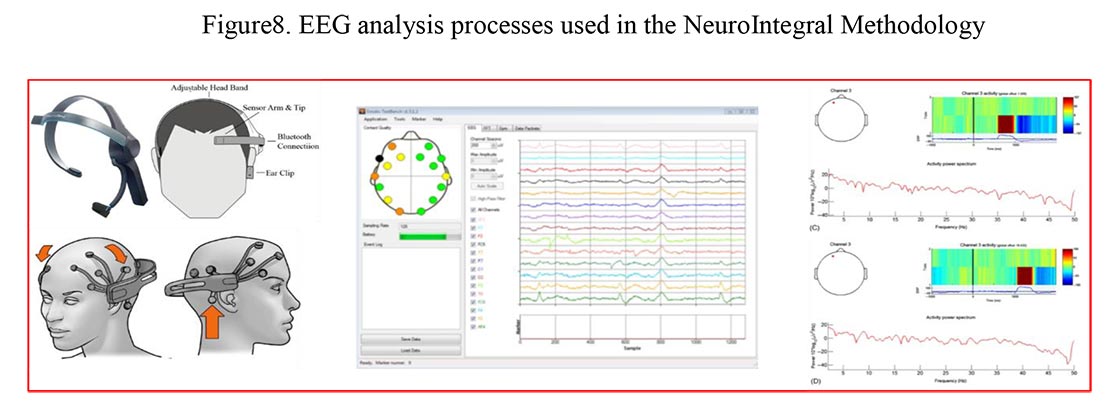
Note. Recording processes, qualitative and quantitative analysis of electroencephalographic activity with various latest generation EEG devices. The analysis and control of applications is proposed from brain-computer interfaces based on EEG (Bansal & Mahajan, 2019).
- Neurointegral Methodology: Practical Implementation
What is the NeuroIntegral Methodology?
It is a pragmatic approach that translates the theoretical principles and scientific evidence on the study of cognition, emotion, social and brain domain in Neuromanagement Adapted to concrete, personalized and person-centered interventions. This methodology focuses exclusively on the implementation of advanced techniques and scientific tools to improve cognitive performance and emotional well-being, based on protocol evaluations obtained through Adapted Neuromanagement (34).
- Key dimensions
Adapted Neuromanagement and NeuroIntegral Methodology raise key dimensions that are oriented to pragmatic work that is carried out through three clearly identifiable goals (Figure 9):
- Prevention: We understand that the best way to solve a problem is through prevention, which is why it is our main work strategy. In this dimension, the design and implementation of programs is carried out to improve general well-being and prevent the development of pathologies through a comprehensive biopsychosocial approach: The main program is the Human Flourishing Program.
- Correction: Mental health is a pressing issue that should not only be worked on from clinical approaches to psychopathology; on the contrary, ‘positive’ interventions are necessary that contribute to enriching people's general well-being, skills and abilities. . For these reasons, our corrective programs are oriented towards the application of specific interventions and treatments to manage and correct existing pathologies, mainly working from neuropsychological guidance. Neuropsychologicalcorrection and rehabilitationprogram (35).
- Optimization: Finally, our third key dimension is oriented to the work of optimizing people's well-being, performance and functioning. To this end, interventions are developed to improve cognitive, emotional and social performance in various groups of people (athletes, executives, students, etc.).
The key dimensions of our methodological work are guided by the three main lines of work for governance in the 21st century and are the basis of working with people for the new millennium, we refer to Wellbeing, Resilience and Sustainability, the new trinity of governance (Joseph & McGregor, 2020). Thus, our methodology aims to work to increase well-being, develop more resilient behaviors in the face of people's contexts, and to provide the basic elements so that behaviors, thoughts and emotions are independently sustainable by the people we accompany in their lives processes (37).
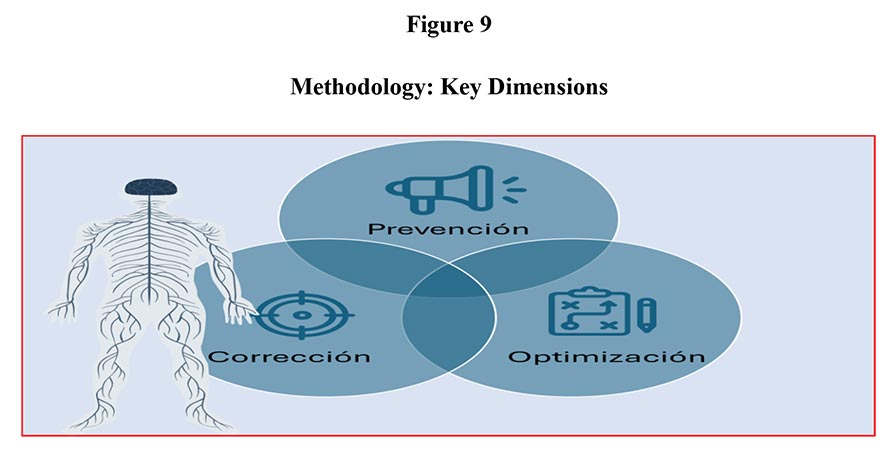
Evaluation Protocol: Adults
Our care protocols involve a biopsychosocial analysis of the people we accompany, so the broad evaluation that is developed allows a 360 NeuroIntegral Evaluation that offers an image of the different processes that constitute the human being in its adaptive behavior, the critical path of Our procedures are carried out in a total of three sessions carefully prepared and adapted to the needs of our clients and people we accompany, the general route is as follows:
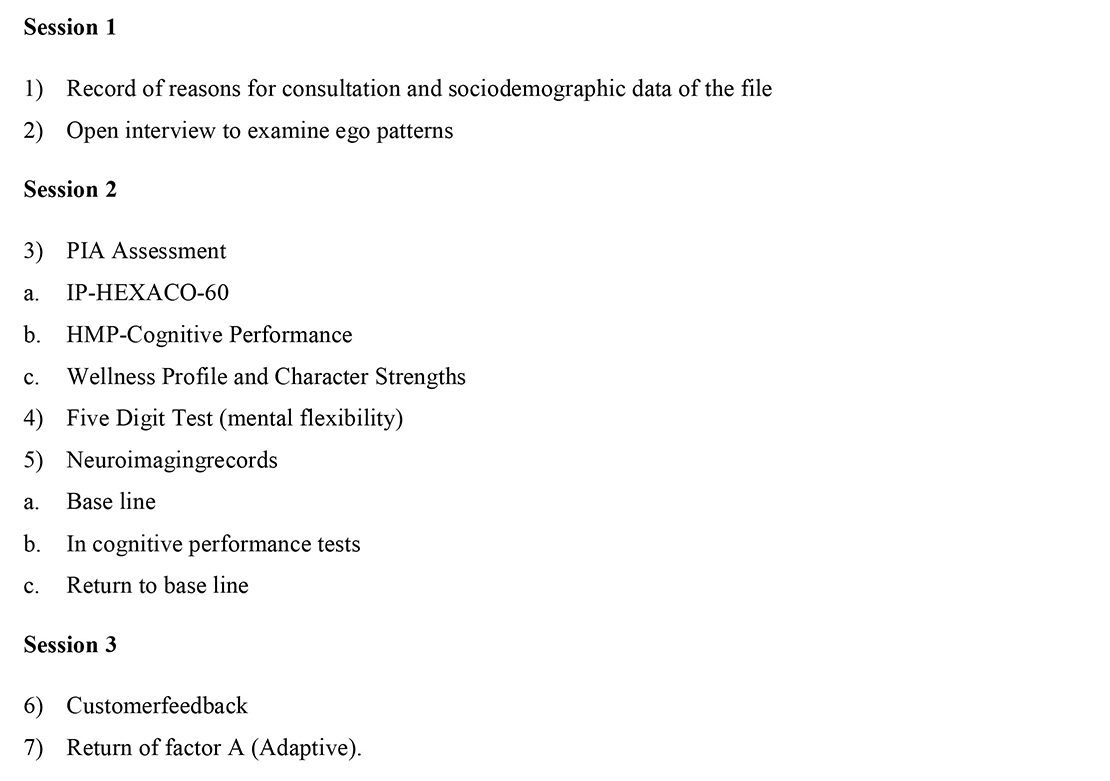
- Evaluation Protocol: Children
Working with school-age children (ages 6 to 12) is vitally important for academic success and life outcomes. Research throughout the life cycle has shown that both cognitive and non-cognitive skills (personality and attitudes) are vital for professional success and to have better life outcomes in different domains such as health, work, life. as a couple or family, and in general to enjoy greater life satisfaction, well-being and intergenerational social mobility (Campos, 2016).
Given these reasons, working with infants is relevant in the NeuroIntegral Methodology, which is why a 360 Evaluation Protocol is developed for this age group. Theevaluationproposesthefollowinganalysisroute:
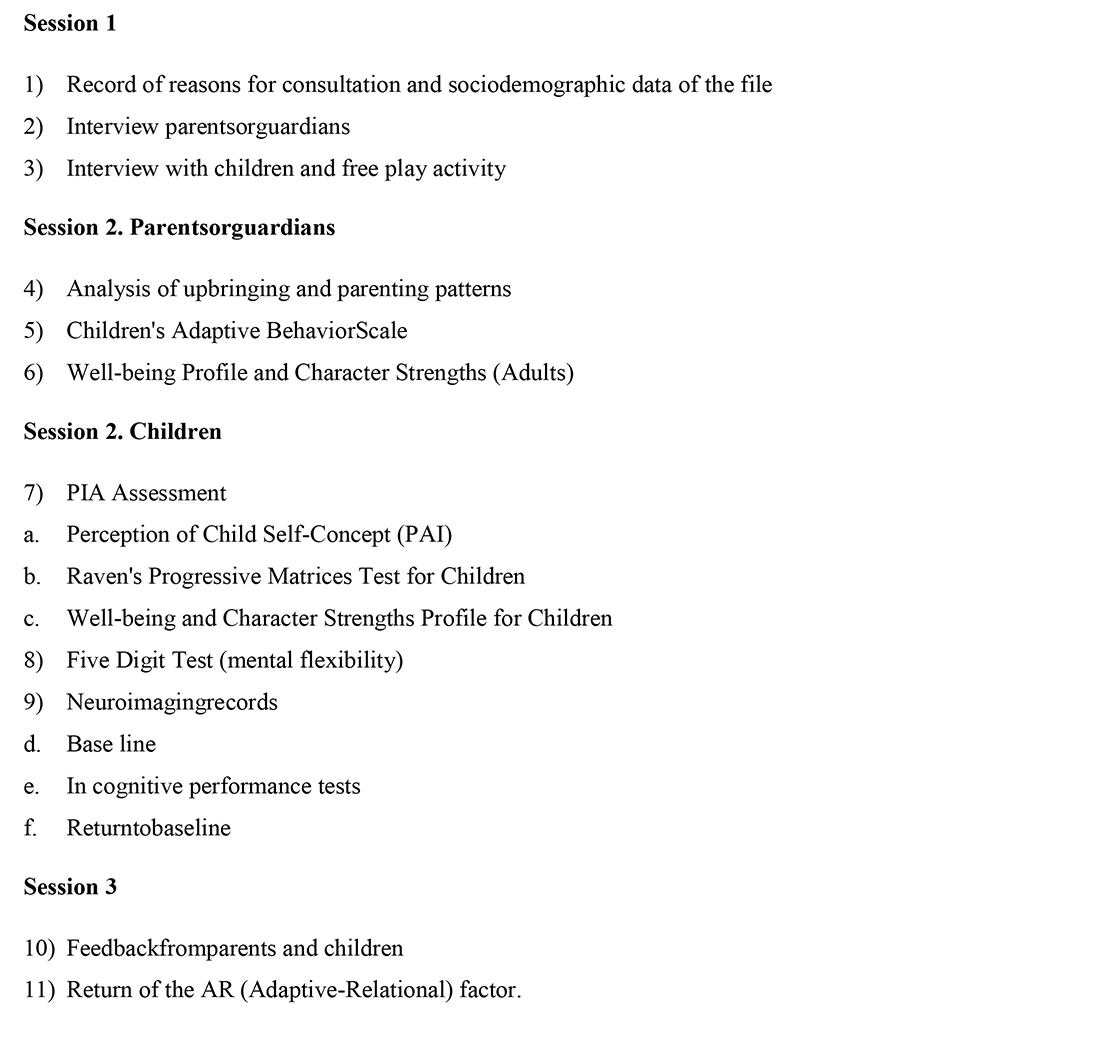
- NeuroIntegral Intervention Programs
Based on the protocol evaluations obtained through Adapted Neuromanagement, we apply a variety of personalized intervention techniques oriented from the NeuroIntegral Methodology. These techniques have given rise to different programs that facilitate timely intervention in the evaluation fields:
Intervention with Neurofeedback and Biofeedback: Personalized training programs to improve neuronal and physiological self-regulation.
Mindfulness and Relaxation Techniques: Implementation of specific protocols to reduce stress and improve attention, adapted to individual needs.
Virtual Reality Exposure Therapy: Development and application of personalized scenarios to treat phobias, anxiety and PTSD, with more than 150 environments available for various therapeutic applications.
Cognitive performance training based on computational interface: Implementation of adaptive programs to improve specific executive and cognitive functions, based on the individual neurocognitive profile (see Figure 7).
Qualitative neuropsychological training: Implementation of rehabilitation and neuropsychological correction programs aimed at improving the psychological and brain functioning of people.
Emotional Freedom Techniques: Application of emotional reprocessing protocols to improve self-regulation, adapted to specific emotional needs.
Guided Neuroplasticity Interventions: Application of cognitive stimulation techniques designed to promote neuroplasticity in specific brain areas.
Character Strengths Program: Implementation of psychological well-being management programs based on scientific evidence.
Personalized Neuromanagement Education: Development and implementation of personalized educational programs on brain functioning, adapted to the level of understanding and needs of each individual or group. - NeuroIntegral Intervention with Children
Neurointegral intervention programs for children use most of the interventions carried out with adults, however, there is an important differentiator in working with neuropsychological factors for the correction and optimization of children's activity. These factors are: programming and control, sequential organization of movements and actions, phonemic hearing, kinesthetic analysis and synthesis, audio-verbal retention, visual retention, perceptual-analytical, global perceptual and cortical tone (González-Moreno, et al., 2012 ), which are described from greater to lesser integrative complexity (see Figure 10).
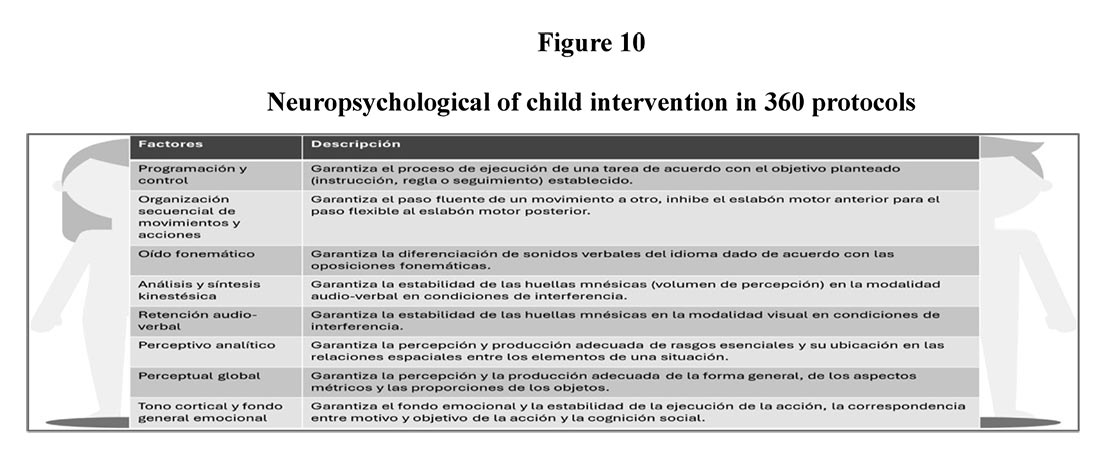
Note. Adapted Neuromanagement and its derivation in the NeuroIntegral Methodology take up the work of sociocultural neuropsychology to provide solutions for neuropsychological correction and rehabilitation in children and adults, therefore it recognizes the impact of the analysis and work from the factors inherent to the activity. Prepared and adapted with information from González-Moreno, et al. (2012). - Implementation Process
- Intervention Design: Based on the results of the multimodal neurocognitive diagnosis, a personalized intervention plan is designed.
- Gradual Application: The techniques are implemented gradually, allowing adaptation and adjustment according to the individual's response.
- Continuous Monitoring: During the intervention, constant monitoring is carried out using the diagnostic tools of Adapted Neuromanagement.
- Dynamic Adjustment: The intervention plan is dynamically adjusted according to the individual's progress and responses.
- Results Evaluation: Established success metrics are used to evaluate the effectiveness of the intervention.
- Scientific Validation
Our adapted Neuromanagement approach contains theoretical-epistemological foundations that have been described in the first part of this document. Its derivation in the NeuroIntegral Methodology is offered from this foundation of practical work that is based on the discoveries and applications of neuromanagement, psychology, artificial intelligence and cognitive management in general, as well as interdisciplinary fields such as neuroeconomics and behavioral economics. Likewise, the methodology has been validated through rigorous case studies and publications in scientific journals. Our recent article ‘Adaptive Neuromanagement and Neuro-Integral Methodology’ presents empirical evidence demonstrating the effectiveness of our interventions in various contexts (38). - Success Metrics
We measure the success of our interventions by:
- Changes in Brain Activity: Using EEG and qEEG, we observed positive changes in brain activity after the interventions.
- Reduction of Stress and Anxiety Levels: We use standardized questionnaires to evaluate reductions in stress and anxiety levels.
- Improvements in Cognitive Performance: Through neuropsychological tests, we measure improvements in executive functions, working memory and attention.
- Participant Feedback: We collect testimonials and evaluations from participants to measure satisfaction and perceived impact.
- Ethical Considerations
All our interventions are carried out under strict ethical standards, with informed consent, guaranteeing the privacy and confidentiality of the data, and respecting the highest ethical standards in research and clinical practice.
Our commitment to social responsibility and innovation raises this strong ethical and bioethical commitment that is reflected in our care protocols:- Safeguarding of files and client information
- Informedconsentforevaluation
- Informedconsentforinterventionprocesses
- Feedbackpapers and adaptive factors
- Ethics protocols in research and intervention
- Limitations and Future Directions
We recognize current limitations and are working on:
- Database Expansion: Collect more data to improve our AI-based predictive models.
- Continuing Research and Longitudinal Studies: Conduct long-term studies to evaluate the lasting effects of our interventions.
- Improved Adaptability and Personalization of Interventions: Continue developing techniques to better adapt them to different populations and contexts.
- Conclusion
ICN, Bogota has created something that truly sets us apart: we “ask” the brain, and it responds. The NeuroIntegral 360 Diagnosis, a powerful tool for well-being and human potential optimization, offers a comprehensive and personalized view of the brain.
This innovative approach, grounded in solid scientific research in neuroimaging, adaptive psychometrics, and cognitive neuromanagement, uses cutting-edge technologies to assess cognitive and emotional functioning in real-world contexts. Complementing traditional clinical assessments, NeuroIntegral 360 provides a holistic perspective that enhances the participant’s understanding and supports informed decision-making about their health and well-being. Through real-life simulations, the diagnosis can detect indicators of potential pathologies or anomalies, facilitating referral to specialized medical care when necessary (Aristóteles (Trad. 2009, 2016).
Paper remains at disposal to discuss in greater depth the technical and methodological aspects. We strongly believe that our approach represents a significant advance in the field of applied neuromanagement and we are excited to share our findings and methodologies with the scientific community (Ashton, M. C. and Lee, K. ;2007, 2020).
Prepare for a quantum leap in understanding and optimizing the human brain. After a decade of intensive research, we present the NeuroIntegral Methodology: an approach that not only revolutionizes neuromanagement but also redefines our interaction with the human mind.
Herman and Neethling Whole Brain Assessment is a powerful tool designed to uncover the unique cognitive preferences and strengths of individuals. This assessment dives deep into the four quadrants of the brain: analytical, practical, relational, and experimental thinking. By evaluating how a person naturally approaches problems, makes decisions, and interacts with others, the assessment provides a comprehensive understanding of their cognitive profile. It not only highlights areas of strength but also identifies potential blind spots, offering valuable insights for personal and professional growth. By leveraging these insights, individuals can enhance their communication, teamwork, and overall effectiveness, fostering a more balanced and holistic approach to challenges and opportunities (39).
In the evolving landscape of talent acquisition, brain-based approaches are setting new standards. By integrating Quantitative Electroencephalogram (QEEG) findings into the recruitment process, organizations can gain profound insights into a candidate’s cognitive functions and mental aptitudes. QEEG assessments provide a detailed map of brain activity, highlighting areas of strength and potential challenges.
This data-driven approach allows recruiters to identify candidates whose cognitive profiles align with the specific demands of a role. For instance, high beta activity might indicate strong analytical and problem-solving skills, while elevated theta activity could suggest creative thinking and innovation potential. By understanding these nuances, companies can match candidates to roles where they are most likely to excel and thrive.
Moreover, brain-based talent acquisition goes beyond traditional metrics like experience and education. It focuses on innate cognitive abilities and neuroplasticity, ensuring a more holistic and precise fit between the candidate and the role. This not only enhances job performance and satisfaction but also contributes to a more dynamic and adaptable workforce, capable of meeting the complex challenges of today’s business environment (Campos, R. ; 2016).
Acknowledgement
The authors are grateful to Prof Dr Julio Ramirez, Director General, ICN< Bogota, Republic of Bogota for his inputs in this paper
References
- Alexander, R., Aragón, O. R., Bookwala, J., Cherbuin, N., Gatt, J. M., Kahrilas, I. J., Kästner, N., Lawrence, A., Lowe, L., Morrison, R. G., Mueller, S. C., Nusslock, R., Papadelis, C., Polnaszek, K. L., Helene Richter, S., Silton, R. L. andStyliadis, C. (2021). The neuromanagement of positive emotions and affect: Implications for cultivating happiness and wellbeing. Neuromanagement and Biobehavioral Reviews, 121: 220–249. https://doi.org/10.1016/j.neubiorev.2020.12.002
- Aristóteles (Trad. 2009). Ética Eudemia. Alianza Editorial.
- Aristóteles (Trad. 2016). Ética a Nicómaco. Alianza Editorial.
- Ashton, M. C. and Lee, K. (2007). Empirical, Theoretical, and Practical Advantages of the HEXACO Model of Personality Structure. Personality and Social Psychology Review, 11(2), 150-166. https://doi.org/10.1177/1088868306294907
- Ashton, M. C. and Lee, K. (2020). Objections to the HEXACO Model of Personality Structure—and why those Objections Fail. European Journal of Personality, 34(4), 492-510. https://doi.org/10.1002/per.2242
- Bansal, D. and Mahajan, R. (2019). EEG-based brain-computer interfaces: Cognitive analysis and control applications. AcademicPress, Elsevier.
- Campos, R. (2016). Inteligencia y personalidad. Efectos en movilidad social y resultados de vida. El Colegio de México, Centro de Estudios Espinosa Yglesias.
This paper provides a comprehensive analysis of subject - patient’s brain activity, cognitive performance, and personality profile, using innovative approach that combines cutting-edge neurofeedback (brain-wave reading), artificial intelligence tools, and personalized analysis of personal narrative. This methodology, based on electroencephalography (EEG) with devices like MyndBand Being considered in subsequent attempts), allows real-time measurement of [Paulo’s] brain activity while experiencing real-life situation simulations, including cognitive tasks, meditation sessions, and auditory distractions. Understanding how brain responds to everyday challenges is key to developing this paper. The paper proposes a Personalized Development Plan, based on test results, outlining clear goals and practical strategies aimed at improving stress management, cognitive flexibility, and decision-making. The ultimate goal is to provide tools that enhance the patient's personal and professional development (Aristóteles; Trad. 2009, 2016).
Methodology
